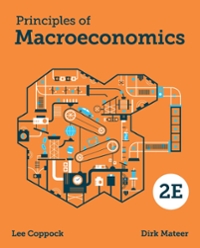Question
ECON 4721, Money & Banking Reference: Modeling Monetary Economics (2016, Fourth Edition, Cambridge University Press) by Bruce Champ, Scott Freeman and Joseph Haslag. Imagine an
ECON 4721, Money & Banking
Reference: Modeling Monetary Economics (2016, Fourth Edition, Cambridge University Press) by Bruce Champ, Scott Freeman and Joseph Haslag.
Imagine an OLG economy where the government has to build roads and bridgestotaling a number of
Gtunitsoftheconsumptiongoodeachperiod.The government may finance its purchases by printing money with a rate ofexpansion of the fiat money supply of
z=1.0. Denote governmentconsumption per capita bygt=Gt/Nt where
Ntisthenumberofpeople born each period. Population grows constantly at rate
n=1.5.Each young person receives 114 units of the consumption good as labor income.Besides money, the agent may invest in capital k. Eachunitinvestedincapitalasyoungwillbecome
f(k)=Ak, where
A=1.2 and
=0.3when old. Find total GDP per capita in the stationary equilibrium. Round your answer to the closest integer.
Step by Step Solution
There are 3 Steps involved in it
Step: 1

Get Instant Access to Expert-Tailored Solutions
See step-by-step solutions with expert insights and AI powered tools for academic success
Step: 2

Step: 3

Ace Your Homework with AI
Get the answers you need in no time with our AI-driven, step-by-step assistance
Get Started


